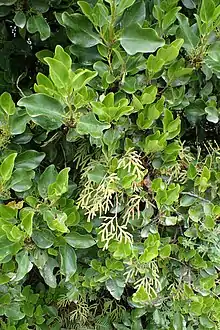| Pseudodiphasium | |
|---|---|
 | |
| Scientific classification | |
| Kingdom: | Plantae |
| Clade: | Tracheophytes |
| Clade: | Lycophytes |
| Class: | Lycopodiopsida |
| Order: | Lycopodiales |
| Family: | Lycopodiaceae |
| Genus: | Pseudodiphasium Holub[1] |
| Species: | P. volubile |
| Binomial name | |
| Pseudodiphasium volubile (G.Forst.) Holub[1] | |
| Synonyms[1] | |
| |
Pseudodiphasium is a genus of lycophyte in the family Lycopodiaceae with only one species, Pseudodiphasium volubile. In the Pteridophyte Phylogeny Group classification of 2016 (PPG I), the genus is placed in the subfamily Lycopodioideae.[2] Some sources do not recognize the genus, sinking it into Lycopodium.[3] Pseudodiphasium volubile is native from Peninsular Malaysia to Queensland, Australia, and has been introduced into Ecuador.[1]
References
- 1 2 3 4 Hassler, Michael (19 January 2023), "Pseudodiphasium", World Ferns. Synonymic Checklist and Distribution of Ferns and Lycophytes of the World, 14.7, retrieved 2023-01-22
- ↑ PPG I (2016), "A community-derived classification for extant lycophytes and ferns", Journal of Systematics and Evolution, 54 (6): 563–603, doi:10.1111/jse.12229, S2CID 39980610
- ↑ "Pseudodiphasium Holub", Plants of the World Online, Royal Botanic Gardens, Kew, retrieved 2019-12-08
This article is issued from Wikipedia. The text is licensed under Creative Commons - Attribution - Sharealike. Additional terms may apply for the media files.